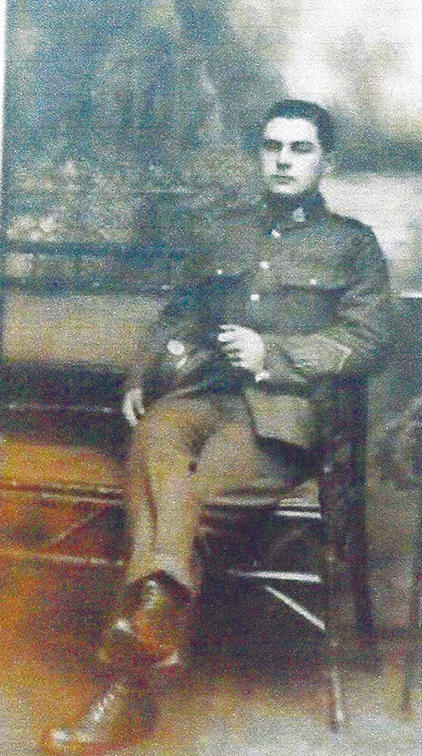Sydney Stuart Fletcher
Sydney Stuart Fletcher’s connection with Dore was through his paternal grandparents, Joseph Fletcher and Elizabeth Hannah Gillatt, who were both born in Dore. However, Joseph and Elizabeth had moved to Shrewsbury Road, near Sheffield Midland Station, by the time their elder son, Walter (Sydney’s father) was baptised on 24th September 1865.
Sydney was born on 16th December 1897 at his parents’ home, 64 Vincent Road, off Sharrow Lane. He was the fourth of five children of Walter Fletcher and his wife Kate, née Walker. He was baptised in St Barnabas’ Church on 12th January 1898.
On 12th January 1915, at Sheffield Town Hall, Sydney enlisted as a Private (Regimental Number 1291) in the 12th Battalion of the York & Lancaster Regiment (the Sheffield City Battalion). He claimed to be 19 years and 1 month old, though in fact he was only 17. At that time, he was a band saw maker, and was unmarried. He was 5’5½” tall, and weighed 123lb; his physical development was said to be good. His distinctive marks were scars on both shins and both elbows. He was living with his parents at 13 Wath Road, Sharrow. According to the Sheffield Daily Telegraph for 29th October 1918, he worked for Messrs. Elsworth and Sons, of Matilda St, Sheffield.
Sydney joined his Battalion on 14th January 1915. After training, he embarked at Devonport on 20th December 1915 and was posted to the Mediterranean, disembarking at Alexandria on 1st January 1916. He remained in that area until 9th March 1916, and was then posted to France on 10th March 1916.
On 18th June 1916, he suffered a serious self-inflicted wound to his upper left arm. The incident was described as follows in the official documentation:
“On the evening of 18th June, Private Fletcher was cleaning his rifle whilst seated on the firestep, in Fort Wagram. Time: about 9.30 pm. He was holding conversation at the time with Private Shelton of 12 th Y & L Rgt., and Private Milner, 12 th East Yorks. His rifle was loaded and negligence was shown by Private Fletcher in that he had the butt of the rifle of (sic) the ground with the muzzle pointing towards him. He was cleaning the Trigger Guard when the rifle went off.”
Sergeant Lavender, who had given the order to clean rifles, heard the shot, went to investigate, and found that Sydney had shot himself through the upper left arm; when he dressed the wound, he found that the bullet had passed straight through his arm and lodged in the side of the trench. Lieutenant-Colonel Crosthwaite, who was commanding the Battalion, stated that, in his opinion, the wound was caused negligently. Sydney was therefore tried by a field general court martial for neglect to the prejudice of good order and military discipline. He was sentenced to 21 days of Field Punishment Number 2 – being shackled in irons for no more than two hours in every 24, and no more than three days in every four, up to a maximum of 21 days.
On 2nd October 1916, Sydney appears to have been admitted to hospital in Étaples suffering from influenza; he was transferred to England on 26th October, and admitted to hospital in Dover from 28th October to 10th November 1916. It is not clear exactly what happened to him in the next six months, but he appears to have been posted to the 10th Battalion of the York & Lancaster Regiment, crossing with them from Folkestone to Boulogne on 30th May 1917. He was in hospital again from 2nd November to 4th December 1917, this time in the 3rd Western General Hospital, Cardiff – the reason for admission is not very legible. He then went home on leave to 13 Wath Road from 4th to 14th December 1917.
This photograph has written on the back “Best wishes from Sydney Xmas 1917”, and was presumably taken when he was home on leave in December 1917. The long service chevron on his left arm indicates that he had served in the army for two years; below that there are three brass wound bars, indicating that he had been wounded three times.
From 21st January to 12th April 1918, Sydney was back in hospital, this time in Ripon, with gunshot wounds to both feet and legs. However, by 27th April 1918 he had recovered sufficiently to return to France, and was posted to the 2nd Battalion of the York and Lancaster Regiment. On 30th April 1918, he was transferred to the 1/5th (TF) Battalion of the York and Lancaster Regiment, and was promoted to Corporal with that Battalion on 20th May 1918.

Sydney was killed in action on 13th October 1918. According to the Sheffield Daily Telegraph for 29th October 1918, his officer wrote that he was struck by a bullet while advancing across a ridge, adding “He was a splendid soldier and fell nobly doing his duty”. He is buried in York Cemetery, Haspres, about 10 miles from Cambrai. He was 20. He was eligible for the Victory and British War Medals. His family still retain his memorial scroll and plaque – the ‘Dead Man’s Penny’ – which were issued to the next-of-kin of all British Empire service personnel who were killed as a result of the war.
Sydney is commemorated on Joseph and Elizabeth Fletcher’s gravestone in Dore churchyard. He is also listed, with his siblings, on the Roll of Honour of St Peter’s Church, Abbeydale Road - now located in St Oswald’s Church, Abbeydale Road, following the demolition of St Peter’s Church in 2003.
Related Topics: Dore in the First World War | Dore's War Memorial | Lych Gate War Memorial | Roll Call of War Dead 1914-1919

